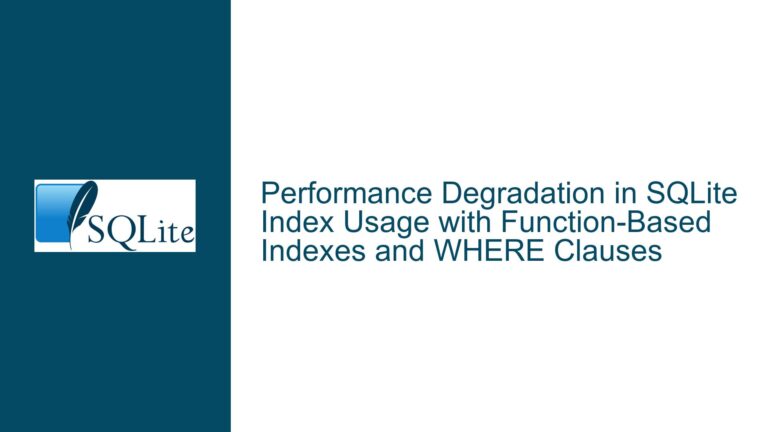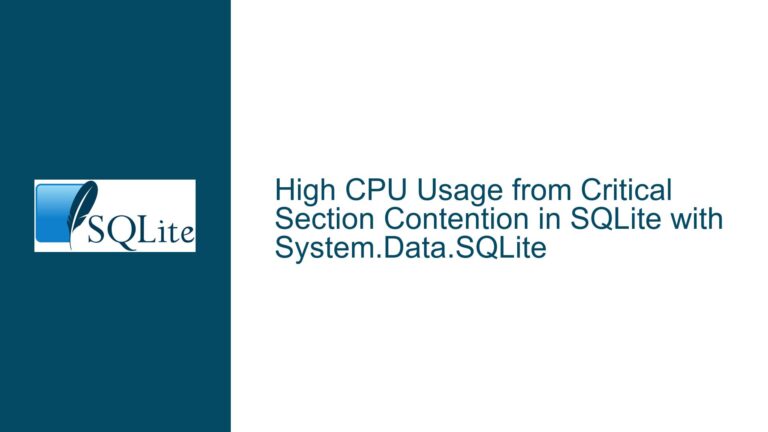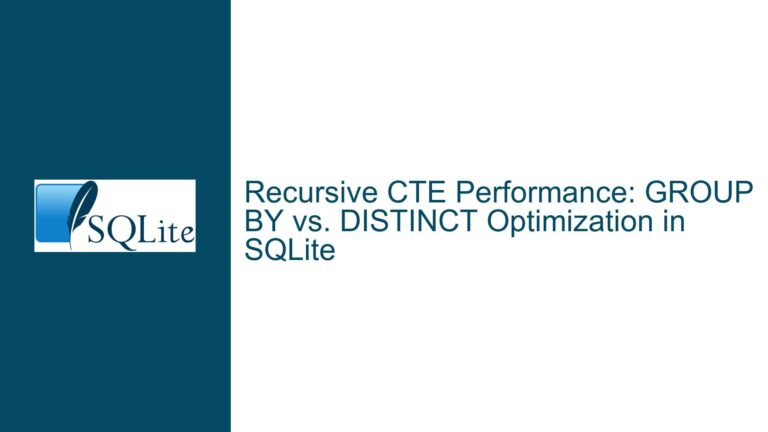Optimizing Virtual Table Group By Performance in SQLite
Understanding the Performance Gap Between Virtual Tables and Native Tables
When working with SQLite, virtual tables (VTabs) offer a powerful way to extend the database’s functionality by allowing custom data sources to be queried as if they were native tables. However, as highlighted in the discussion, there is a noticeable performance gap when executing GROUP BY queries on virtual tables compared to native tables, even when the underlying data is optimized. This post delves into the reasons behind this discrepancy and provides actionable steps to mitigate the performance issues.
The core issue revolves around the execution of a GROUP BY query on a virtual table that is backed by a sorted array of strings. Despite the data being pre-sorted and the orderByConsumed flag being set, the query performance is still significantly slower than when the same operation is performed on a native table with an index. The discussion also reveals that the query plan for the virtual table involves a temporary B-tree for grouping, whereas the native table leverages a covering index, resulting in a substantial difference in execution time.
To fully understand and address this issue, we need to explore the internal mechanisms of SQLite’s query execution, the limitations of the virtual table interface, and the specific optimizations available for native tables. By the end of this post, you will have a comprehensive understanding of the factors contributing to the performance gap and the steps you can take to improve the efficiency of GROUP BY operations on virtual tables.
Exploring the Role of Indexing and Query Execution Plans
The performance discrepancy between virtual tables and native tables in SQLite can be largely attributed to the differences in how indexing and query execution plans are handled. In the case of native tables, SQLite can leverage covering indexes to significantly speed up GROUP BY operations. A covering index is an index that includes all the columns required by the query, allowing the database engine to retrieve the necessary data directly from the index without accessing the underlying table. This eliminates the need for additional lookups and reduces the overall query execution time.
In contrast, virtual tables do not have the same level of integration with SQLite’s indexing mechanisms. While the orderByConsumed flag can inform SQLite that the data is already sorted, the virtual table interface does not provide a way to fully emulate the behavior of a covering index. As a result, SQLite must still perform additional processing, such as building a temporary B-tree for grouping, which introduces overhead and slows down the query.
The query execution plans provided in the discussion illustrate this difference. For the virtual table, the plan shows a scan of the virtual table followed by the use of a temporary B-tree for grouping. On the other hand, the native table with an index shows a scan using the covering index, which is significantly faster. This highlights the importance of indexing in optimizing query performance and the challenges of achieving similar efficiency with virtual tables.
To bridge this gap, it is essential to understand the specific limitations of the virtual table interface and explore alternative strategies for optimizing GROUP BY operations. This includes examining the implementation of the xNext and xColumn functions, considering the use of additional data structures to precompute aggregates, and evaluating the trade-offs between different approaches to data storage and retrieval.
Strategies for Improving Virtual Table Group By Performance
Given the limitations of the virtual table interface, there are several strategies that can be employed to improve the performance of GROUP BY operations on virtual tables. These strategies focus on minimizing the overhead associated with data retrieval and processing, as well as leveraging the strengths of the virtual table implementation to achieve better performance.
One approach is to optimize the implementation of the xNext and xColumn functions to ensure that they are as efficient as possible. Since these functions are called repeatedly during query execution, any inefficiencies in their implementation can have a significant impact on overall performance. This may involve using more efficient data structures, such as linked lists or hash tables, to store and retrieve the data, as well as minimizing the amount of computation performed within these functions.
Another strategy is to precompute aggregates or other summary statistics within the virtual table implementation itself. By maintaining a count of the number of occurrences of each value in the array, for example, the virtual table can return the results of a GROUP BY query without requiring SQLite to perform additional processing. This approach can be particularly effective when the data is static or changes infrequently, as it allows the virtual table to serve precomputed results directly to the query engine.
Additionally, it may be beneficial to explore the use of custom indexing mechanisms within the virtual table implementation. While the virtual table interface does not provide direct support for covering indexes, it is possible to implement custom indexing logic that mimics the behavior of a covering index. This could involve maintaining a separate data structure that stores the values and their corresponding counts, allowing the virtual table to return the results of a GROUP BY query without accessing the underlying array.
Finally, it is important to consider the trade-offs between using virtual tables and native tables for specific use cases. While virtual tables offer flexibility and extensibility, they may not always be the best choice for performance-critical operations. In cases where the primary goal is to achieve the highest possible query performance, it may be more effective to use native tables with appropriate indexing and optimization techniques.
By carefully evaluating these strategies and tailoring them to the specific requirements of your application, you can significantly improve the performance of GROUP BY operations on virtual tables and reduce the performance gap with native tables. The following sections provide detailed guidance on implementing these strategies and addressing the specific challenges associated with virtual table performance optimization.
Detailed Troubleshooting Steps and Solutions
To address the performance issues with GROUP BY operations on virtual tables, it is essential to follow a systematic approach that involves analyzing the current implementation, identifying bottlenecks, and applying targeted optimizations. The following steps provide a comprehensive guide to troubleshooting and resolving these issues:
Analyze the Query Execution Plan: Begin by using the
EXPLAIN QUERY PLANstatement to analyze the query execution plan for both the virtual table and the native table. Compare the plans to identify any differences in how SQLite processes the data. Pay particular attention to the use of temporary B-trees, the presence of covering indexes, and the number of times thexNextandxColumnfunctions are called.Optimize the Virtual Table Implementation: Review the implementation of the virtual table, focusing on the
xNextandxColumnfunctions. Ensure that these functions are as efficient as possible by minimizing the amount of computation and data retrieval performed within them. Consider using more efficient data structures, such as linked lists or hash tables, to store and retrieve the data.Precompute Aggregates: If the data in the virtual table is static or changes infrequently, consider precomputing aggregates or other summary statistics within the virtual table implementation. This can significantly reduce the amount of processing required during query execution and improve overall performance.
Implement Custom Indexing: Explore the possibility of implementing custom indexing mechanisms within the virtual table to mimic the behavior of a covering index. This could involve maintaining a separate data structure that stores the values and their corresponding counts, allowing the virtual table to return the results of a
GROUP BYquery without accessing the underlying array.Evaluate the Use of Native Tables: Consider whether the use of native tables with appropriate indexing and optimization techniques would be more effective for your specific use case. While virtual tables offer flexibility and extensibility, they may not always be the best choice for performance-critical operations.
Benchmark and Iterate: After applying the above optimizations, benchmark the performance of the virtual table to assess the impact of the changes. Use the results to identify any remaining bottlenecks and iterate on the optimization process until the desired level of performance is achieved.
By following these steps, you can systematically address the performance issues associated with GROUP BY operations on virtual tables and achieve significant improvements in query execution time. The key is to carefully analyze the current implementation, identify the root causes of the performance gap, and apply targeted optimizations that leverage the strengths of the virtual table interface while minimizing its limitations.






